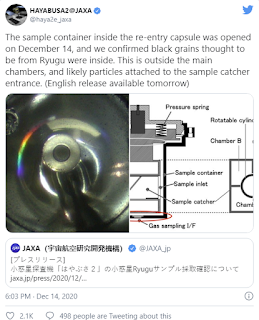Japanese researchers have gotten their first look inside the example container of the Hayabusa2 shuttle, and even the principal look is encouraging.
The Hayabusa2 shuttle dispatched in 2014, destined for a close Earth space rock called Ryugu. The mission showed up at Ryugu in 2018 and went through about eighteen months noticing and inspecting the space rock prior to leaving a year ago to store its example case in Earth's environment. On Dec. 5, that container arrived in the Woomera Prohibited Area in Australia; researchers with the Japan Aerospace Exploration Agency (JAXA), which runs the mission, at that point flew the case to Japan.
On Monday (Dec. 14), mission faculty got their first look inside the container. "We affirmed dark grains thought to be from Ryugu were inside," mission agents composed on Twitter. "This is outside the principle chambers, and likely particles connected to the example catcher entrance."
Researchers later opened one of the three example chambers and affirmed that it contained a decent lot of space rock dust. Those chambers hold the genuine fortunes: they are the place where the Hayabusa2 shuttle coordinated the bits of Ryugu it caught during two assortment moves.
During one of those examining endeavors, the shuttle snatched rocks from the space rock's surface; during the second, it shot a copper projectile into the space rock to reveal subsurface material. The blend ought to permit researchers to see how the brutal climate of room has influenced the outside of Ryugu.
Another early methodology led on the recently returned case was to quantify gases caught inside it on the off chance that a portion of that gas starts from Ryugu itself.
JAXA has not yet declared when researchers will start dissecting the space rock bits vigorously. Regardless of Earth's modern armada of rocket, dissecting pieces of different universes in earthbound labs actually gives researchers considerably more remarkable approaches to address planetary science questions.
Since space rocks are early stage rubble left over from when the nearby planetary group framed, researchers trust that considering these examples of Ryugu will assist them with understanding the beginning of the close planetary system.









No comments:
Post a Comment